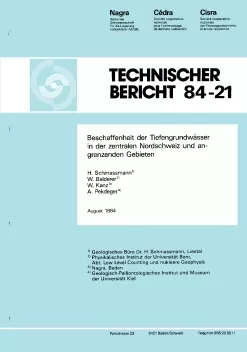
Technischer Bericht NTB 84-21
Beschaffenheit der Tiefengrundwässer in der zentralen Nordschweiz und angrenzenden Gebieten
The first part of the report NTB 84-21 introduces the programme of investigations used by Nagra since 1981 to examine regionally the properties of the deep groundwaters in Northern Switzerland and adjacent areas. The data of this programme provide a regional information system for the waters punctually found in the deep borings of Nagra.
Following a discussion of the investigation goals a review of the sampling points and the methods of data collection are presented. The investigations were conducted to define the physical properties of the water, the dissolved and undissolved components including microorganisms in the water, and the isotopic composition of the water and its components. This effort includes many geochemical parameters from the groundwaters of the region for which little data previously existed. The electronic data processing described in the report includes plausibility checks, graphical representations, correlation calculations, multivariate analyses and thermodynamic models.
The second part of the report is devoted to preliminary interpretations of the available investigation results. In addition, the analysis from the deep boring programme are considered. Selected aspects of the hydrogeologic interpretation in the present report are the stable isotopes in the water and in the dissolved sulfates, and a classification of the waters according to their principal components.
The most important data and their interpretation are discussed in detail according to the aquifer formations. Waters of different origins can be distinguished by principal and accessory components, by the relationships and correlations among water components as well as by multivariate methods, mainly cluster-analysis. In this way hydrologic connections between aquifers from different formations may be recognized. Information regarding water retention time in the subsurface is based on determinations of Tritium, Argon-39 and Carbon-14 (with respect to Carbon-13).
The final chapter refers to relationships within the major geological structures and contains conclusions with regard to the hydrogeologic synthesis of the deep groundwater flow regimes of Northern Switzerland, of particular importance to hydrodynamic modelling.
